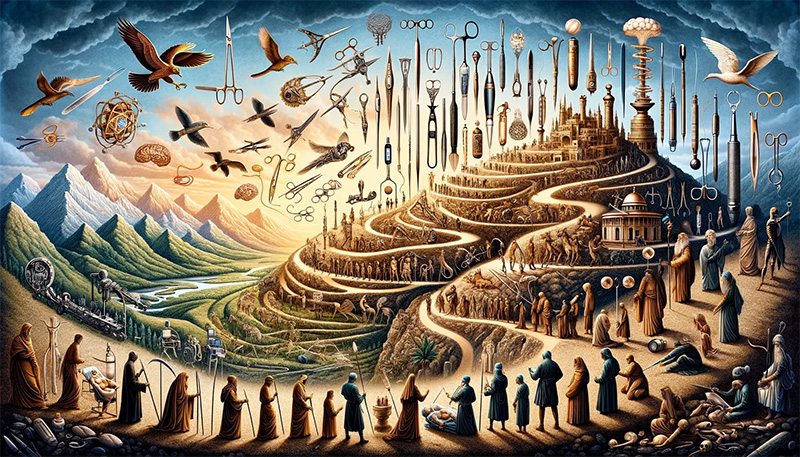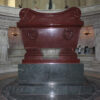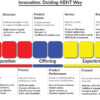
The transformation of surgical instruments from simple scalpels to complex robotic systems is a testament to the remarkable progress in medical science. This journey, spanning several millennia, reflects humanity’s relentless pursuit of innovation and a deeper understanding of the human body. Let’s embark on this fascinating historical voyage.
Sushruta’s Legacy: The Dawn of Surgery in Ancient India
Sushruta (flourished c. 6th century BCE), an ancient Indian surgeon, laid the foundational stones of surgery with his pioneering operations and techniques. His influential treatise, the Sushruta-samhita, stands as a monumental source of knowledge about surgery in ancient India. For Sushruta, the concept of shalya tantra (surgical science) was all-encompassing. His ground-breaking operations included rhinoplasty (the repairing or remaking of a nose), the removal of a dead foetus, and lithotomy (surgical incision into hollow organs such as the urinary bladder to remove stones, or calculi). Sushruta’s ingenuity extended to developing many unique and practical techniques for dissecting the human body and studying its structure, marking him as a true pioneer in surgical history.
Ancient Beginnings: The Foundations of Surgery
In ancient Egypt, the art of surgery was in its nascent stage. Surgeons used rudimentary tools like knives and saws, crudely fashioned from copper and bronze. The “Edwin Smith Papyrus,” one of the earliest known medical documents, provides evidence of these early instruments, indicating an embryonic yet foundational understanding of surgical procedures. This period set the stage for future advancements, laying the groundwork for a more refined approach to surgery.
Greek and Roman Era: Sophistication and Refinement
Advancing into the Greek and Roman era, we witness a more sophisticated array of surgical instruments. The legendary Greek physician Hippocrates introduced scalpels and catheters, revolutionizing surgical practice. Meanwhile, Galen, a prominent Roman physician, described tools like the speculum and surgical scissors. These innovations marked a significant leap from earlier instruments, showcasing the era’s growing comprehension of surgical needs.
The Middle Ages: Islamic Medicine’s Golden Contributions
The Middle Ages saw Islamic medicine bring revolutionary changes to surgery. Albucasis, an influential figure in this era, authored “Al-Tasrif,” a medical encyclopedia that depicted over 200 surgical instruments. His designs, including specialized forceps and trocars, demonstrated an era of increased precision and specialization in surgery, a stark contrast to the rudimentary tools of earlier times.
Renaissance Breakthroughs: Surgeons as Innovators
The Renaissance was a period of exponential growth in medical knowledge. Ambroise Paré, a renowned French surgeon, introduced a plethora of innovative tools, including ligature needles and arterial forceps. These inventions drastically improved post-surgical outcomes, reducing the risks of infection and hemorrhage, and showcased the evolving role of the surgeon as an innovator and scientist.

19th Century: The Dawn of Sterilization and Refinement
The 19th century marked a pivotal shift in surgical practice with Joseph Lister’s introduction of antiseptic techniques, fundamentally altering the surgical landscape. This period also saw the refinement of surgical tools by pioneers like John Weiss and James Sims. Their inventions, such as Sims’ speculum and Weiss’ amputation saws, became staples in surgical practice, reflecting a growing emphasis on precision and patient safety.
20th Century: The Advent of Minimally Invasive Techniques
The 20th century heralded the era of minimally invasive surgery with the introduction of laparoscopes and endoscopes. Innovations like Rudolf Schindler’s endoscope, Hopkin’s rod lens sysems and John Gibbon’s heart-lung machine exemplified the era’s innovative spirit, paving the way for surgeries that were less traumatic and offered quicker recovery times.
The Digital Revolution: A New Frontier in Surgery
Today, we stand in the digital age of surgery, characterized by cutting-edge technologies like the da Vinci and India’s Mantra Surgical System. These systems represent the pinnacle of surgical precision and minimally invasive techniques, incorporating advanced robotics, real-time imaging, and enhanced dexterity. The digital revolution in surgery is not just about the tools; it’s a paradigm shift in the surgical approach, emphasizing patient safety, precision, and optimal outcomes.
Epilogue: Standing on the Shoulders of Giants
The evolution of surgical instruments is a narrative of human ingenuity and the relentless pursuit of improvement. Each era brought its challenges and breakthroughs, contributing to a cumulative body of knowledge and expertise. We stand on the shoulders of giants, those who dared to innovate and challenge the status quo. This historical journey is not just a testament to our past but a beacon for the future, inspiring continued innovation and excellence in the field of surgery. As we look ahead, the fusion of technology, science, and medicine promises to usher in new frontiers, redefining what is possible in surgical care.
Prof. Dr. Prahlada N. B
21 December 2023
Chitradurga.

















Prahlada Sir,
I am not joking !
The earliest doctors used their teeth, fingers and fingernails. Later, they used sharp stones like flint, then iron and steel. But what might surprise everyone is that early use of fingers and teeth for surgery are what shaped the advanced instruments that are still used today.
Overall, the evolution of surgical instruments has been driven by a combination of technological advancements, improved materials, & of course a better understanding of surgical techniques ; all these have made surgeries safer , reduced patient recovery times &, overall patient satisfaction & success in surgeries is achieved with ease.
Reply